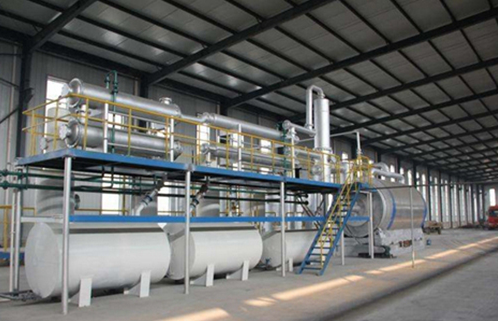Pyrolysis of oil sludge is also called thermal cracking of oil sludge. It is to decompose organic matter in an oxygen-free state to: 1 solid residue mainly composed of coke and carbon black; 2 in liquid form at normal temperature of fuel oil; 3 chemical decomposition process of flammable gas mainly composed of H2, CO, CH4 and some low molecular hydrocarbons. The compounds in the oil sludge are mainly hydrocarbons, including alkanes, alkenes, naphthenes, aromatic hydrocarbons, colloids, asphaltenes and the like. In the state of anoxic or anaerobic conditions, the compounds in the oil sludge undergo a series of complex chemical processes such as dehydrogenation and chain scission under high temperature heating conditions. These processes are mainly divided into two categories: one is endothermic pyrolysis. The reaction process, the second is the exothermic condensation reaction process.
At present, the mechanism of pyrolysis of a relatively recognized hydrocarbon compound such as oil sludge is a radical chain reaction mechanism. The free radical reaction of hydrocarbon pyrolysis such as oil sludge is divided into three stages: chain initiation, chain growth and chain termination.
(1) Pyrolysis stage of oil sludge
The pyrolysis chain initiation stage of the oil sludge is mainly the generation of hydrocarbon radicals such as oil sludge, and the hydrocarbon molecules are decomposed into radicals due to the breakage of the C-C bond, and the sites where the different hydrocarbons break are different. The main part of the break of the C-C bond of the alkane occurs in the middle of the carbon chain. The position at which the olefin breaks is mainly at the C=C double bond, and the position at which the alkyl aromatic hydrocarbon breaks is mainly at the β position of the aromatic ring.
(2) Oil sludge slowing chain growth stage
The growth stage of the pyrolysis chain of the oil sludge is mainly the conversion of the free radicals of hydrocarbons such as oil sludge, and one free radical is converted into another free radical. It is the repeated transfer of free radicals that causes the reaction to proceed continuously. The specific reaction process is as follows:
a) Free radical hydrogen scavenging in the pyrolysis stage of oil sludge
The free radical hydrogen abstraction reaction of the oil sludge pyrolysis stage is as follows:
H + RH = H2 + R ………………………………..Stage (1-1)
R + RH = RH + R ………………………………..Stage (1-2)
The C-H bond energy on the primary, secondary, and tertiary carbon atoms is different, resulting in a different degree of difficulty in capturing hydrogen on the carbon atom. Studies have shown that the order of difficulty in capturing hydrogen at different positions on the carbon atoms of hydrocarbon molecules in oil sludge (from easy to difficult) is: tertiary carbon > secondary carbon > primary carbon, and the reaction rate of free radicals is also the same as above.
b) Free radical decomposition in the pyrolysis stage of oil sludge
In the pyrolysis stage of oil sludge, the free radical itself will decompose and decompose to form two parts: the olefin molecule and another free radical, so that the free radicals are continuously transmitted. It is known from the β-fracture rule that the main site of this special reaction of free radicals is mostly on the β-site carbon of unpaired electrons.
c) Free radical addition in the pyrolysis stage of oil sludge
Compared with the free radical decomposition reaction, the addition reaction of free radicals in the pyrolysis stage of oil sludge can be considered as the reverse reaction. An olefin molecule can be combined with a free radical to form a new radical with a relatively high carbon number.
d) Free radical shift in the pyrolysis stage of oil sludge
The displacement of free radicals in the pyrolysis stage of oily sludge is mainly caused by the internal transfer of hydrogen inside the free radicals, which causes the free radicals to shift. This situation mostly occurs on the alkyl radicals with carbon number >6.
(3) Chain termination stage of oil sludge pyrolysis stage
In the pyrolysis stage of oil sludge, a binding reaction can also occur between the free radical and the free radical. When the free radicals are combined to form a stable hydrocarbon fraction, the chain reaction is terminated.



